mobile View, to the German Version tap the flag


- Austrian Littoral (Österreichisches Küstenland)
- former administration area of the Austrian imperial state
- incorporation of the crown lands of
• Gorizia and Gradisca
• Istria
• Trieste
- German: Österreichisches Küstenland,
• Latin: Litorale,
• Italian: Litorale Austriaco,
• Slovenian: Avstrijska Primorska,
• Croatian: Austrijsko Primorje,
• Hungarian: Tengermellék
• Flag
• Coat of Arms
• Meaning/Origin of the Coat of Arms
• Map of the crown lands of the Littoral
• Map of the former crown lands of Austria-Hungary (to 1918)
• historical Maps about the Littoral
• Numbers and Facts
• History
Between 1849 and 1861, the Austrian Littoral was an own crown land in the Austrian Empire. In 1861 it was divided into three further crown lands, which existed until 1918: Margraviate of Istria, Princely County of Gorizia and Gradisca and the Imperial Free City of Trieste with its surrounding area. The head of state (a by the emperor appointed governor), however, remained the "Governor for the Austrian-Illiric Littoral" with his seat in Trieste. Also laws, which were passed by the severally crown lands had to be published in the joint state law gazette: "Laws and regulations of the state authorities for the Austrian-Illirical Littoral". The Austrian Littoral no longer had its own colors or flag, at least from 1861. However, the governor used a coat of arms that was combined from the coats of arms of the three crown lands. About the period between 1849 and 1861 is no information available here. A horizontally striped flag in yellow, red and blue can be found on the Internet, the authenticity of it cannot be proven.


1849–1867,
Coat of arms of Austrian Littoral,
Source, by: Wikipedia (D)
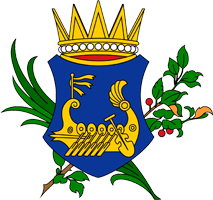
1816–1849,
The Austrian Littoral belongs to the Habsburg Kingdom of Illyria,
Source, by: Ströhl, Wappenrolle Österreich-Ungarns, 1890, via Wikipedia (D)

The coat of arms of the Austrian Littoral is divided into four fields and shows the heraldry of the County of Gorizia in the first field, of the County of Gradisca in the second field, Trieste in the third field and Istria in the fourth field.
Source: Wikipedia (D)

Map ca. 1910:
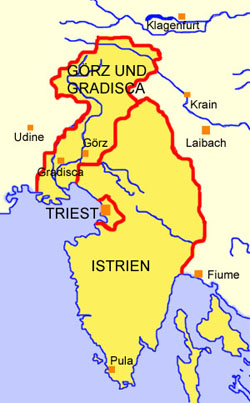
Source: Volker Preuß

Map ca. 1910:
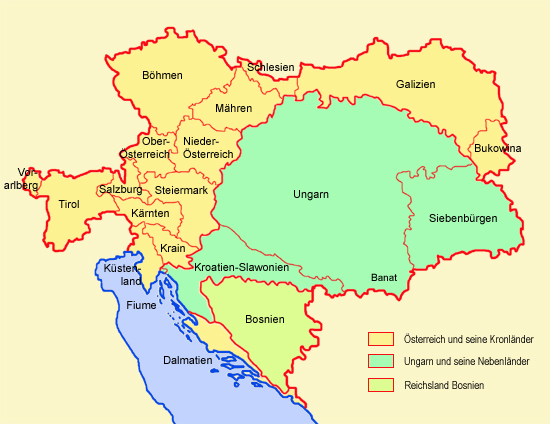
Source: Volker Preuß

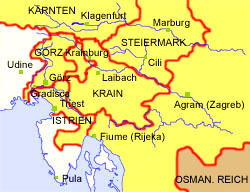
ca. 1526
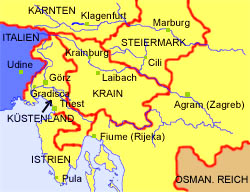
1849
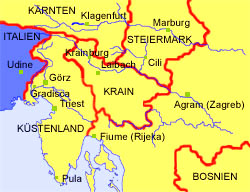
1880
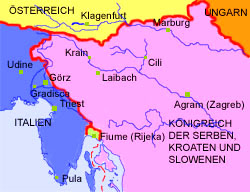
1921
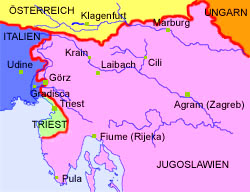
1950
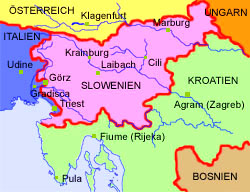
2005
Maps: Volker Preuß

Area: 3.077 square miles (1910)
Inhabitants: 894.300 (1910), thereof 40% Italians, 30% Slovenes, 20% Croatians, 3% Germans
Density of Population: 291 inh./sq.mi. (1910)
Capital: Triest (today's Italian name: Trieste), 145.000 inh. (1880), 234.700 inh. (2018)
Languages (1910): Italian, Slovanian, Croatian, German
Time Zone: GMT + 1 h
Source: Brockhaus Konversationslexikon,
Wikipedia (EN)

ca. 15 A.D. · the conquest of the Littoral Region by the Roman Empire is finished, to the Province of Pannonia Superior
395 · at the partition of the Roman Empire the Littoral Region comes to the West Roman Empire (Rome)
476–489 · the Littoral Region belongs to the Empire of the Odoaker
489–553 · the Littoral Region belongs to Empire of the Eastern Goth
6th cent. · settlement by Slavic tribes
569–598 · conquest by the Awars
ca. 800 · the today's Littoral Region becomes subjected by the Frankish Empire of the Carolingians, formation of the "Mark Krain", administration by the Margrave and Duke of Friaul
934 · the Mark Krain comes to Bavaria
976 · Küstenland comes to the Duchy of Carinthia
1394 · Krain (incl. the Littoral Region) becomes an own Duchy of Habsburg
1797–1809 · French Revolutionar Wars, parts of Austria (Styria) become occupied by the French in 1797
1809 · Peace of Vienna, Austria loses Salzburg, the Inn Quarter, Western Galicia and parts of Eastern Galicia and cedes Istria, Trieste, Gorizia, Carniola, Carinthia, Croatia, and Dalmatia to France, which were merged in 1810 to the French "Illyrian Provinces"
1813 · Austria declares war on France (Napoléon)
1814/1815 · Congress of Vienna, realignment of Europe after the era Napoléon, the Empire of Austria (House of Habsburg) acquires back the in 1809 lost territories; Istria, Trieste, Gorizia, Carinthia and Carniola become merged to the Habsburg's Kingdom of Illyria, Dalmatia and Croatia become re-annexed to Hungary (under the Habsburgs, part of the Empire of Austria)
1848/1849 · revolution in Vienna, civil war between Hungarians and Croats, riotings in Prague, Mailand and Venice, as a result of that Emperor Ferdinand I. resigns and Franz Joseph I. of Habsburg becomes new Emperor, the riotings become suppressed and he enacts a new constitution: the titular hereditary territories of the Habsburgs in the Austrian Empire become converted to crown lands with their own Landtag (parliament), the Landtag of Dalmatia rejects the annexion to Croatia, the Kingdom of Dalmatia becomes an own crown land of the Austrian crown, Croatia and Slavonia become united to the "Kingdom of Croatia and Slavonia", which remains as a subsidiary country under the Hungarian crown, dissolution of the Kingdom of Illyria: division in the crown lands of Carniola, Carinthia, Littoral, Croatia and Slavonia and Dalmatia
1861 · new Austrian constitution, the three components of the Littoral, Margraviate of Istria, Princely County of Gorizia and Gradisca and the Imperial Free City of Trieste and its surrounding area, become own crown lands with their own parliaments, but under a common head of state, the governor of the Austrian-Illiric Littoral with his seat in Trieste
1914–1918 · First World War, thereafter breakdown of the imperial-royal monarchy, disintegration of Austria-Hungary in national states
10th of September 1919 · Treaty of Peace of Saint-Germain after the First World War, Austria has to cede Littoral to Italy and to the "Kingdom of the Serbs, Croats and Slovenes" (since 1929 named Yugoslavia)
1945 · conquest and occupation of the area by Yugoslav partisans at the end of the Second World War, expulsion and partially even assassination of the largest part of the in the country remained German civilian population, Littoral becomes once more divided between Italy and Yugoslavia
Source: Atlas zur Geschichte,
Meyers Konversationslexikon,
Wikipedia (D),
Discovery '97,
Volker Preuß

Further Austria pages (historical flags and coats of arms):
• Empire of the Austrian Habsburgs (to 1804)
• Empire of Austria (1814–1867)
• Austria-Hungary (1867–1918)
• Republic of Austria (since 1918)

![]()











![]()
